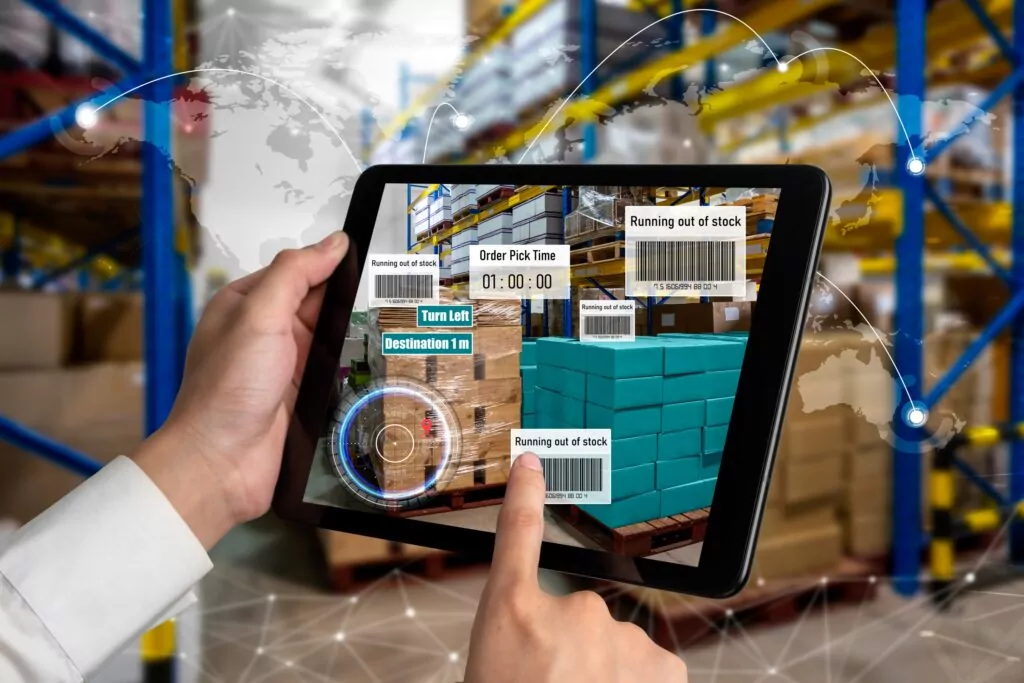Our latest article dug into digital transformation in the supply chain and its benefits. This time, we’re going a tad deeper into particular tech solutions improving logistic systems.
Supply chain 4.0
Supply Chain 4.0 refers to the digital transformation of the traditional supply chain model, integrating technologies such as automation, big data analytics, the Internet of Things (IoT), and artificial intelligence (AI). These technologies offer numerous opportunities for businesses to streamline their supply chain operations, improve efficiency, and enhance customer experience. Here are some of the digital transformation opportunities that enterprises can take advantage of in Supply Chain 4.0.

Internet of Things (IoT)
The Internet of Things supports supply chains by providing real-time visibility and insights into the movement of goods and resources. IoT devices can be embedded in everything from trucks and containers to individual products, enabling businesses to track inventory levels, monitor equipment performance, and optimize transportation routes. This level of control can improve efficiency, reduce costs, and enhance customer satisfaction. For example, IoT sensors can monitor the temperature and humidity of perishable goods during transit, ensuring that they are kept in optimal conditions and the risk of spoilage is reduced. Similarly, IoT-enabled asset tracking can provide real-time updates on the location and condition of goods, reducing the risk of loss or theft.
Furthermore, IoT can help businesses to better manage their inventory by providing real-time updates on stock levels and identifying when and where items are being used. It can help to avoid stockouts and overstocking, ensuring that resources are used efficiently and waste is minimized. As a result, IoT enables more efficient and sustainable logistics operations.
Automation solutions
Business process automation has become a key driver of supply chain transformation. As a result, businesses can reduce errors, save time, and increase productivity by ceding repetitive and manual tasks to machines. Itis possible through employing technologies such as robotic process automation (RPA) and artificial intelligence (AI) to perform tasks such as data entry, inventory management, and order processing faster and more accurately than human workers.
One of the key benefits of automation is the ability to increase agility and responsiveness in the supply chain. Businesses can quickly adapt to changing market conditions, and customer needs by automating demand forecasting and production planning processes. It can reduce lead times and improve the speed and accuracy of order fulfillment. In addition, automation can provide real-time updates on inventory levels, order status, and production schedules to all stakeholders. It can help with improving coordination and reduce the risk of delays or disruptions.
Data analytics and artificial intelligence (AI)
By leveraging data analytics and AI, businesses can identify patterns and trends in their supply chain data, making more informed decisions and optimizing their operations. Benefits can include identifying areas for cost savings, improving inventory management, and predicting demand patterns. AI can also be used to automate decision-making processes, including scheduling production, routing shipments, and managing inventory levels. In adition, data analytics and AI can help businesses better understand customer behavior and preferences, enabling them to tailor their products and services to meet evolving needs. As a result, companies reduce errors, increase efficiency, and improve customer satisfaction, including transaction categorization.
Blockchain
By using a distributed ledger system, blockchain provides a secure and tamper-proof record of all transactions and activities across the supply chain. As a result, enterprises can reduce the risk of fraud, errors, and disputes while increasing accountability and transparency. Moreover, blockchain can be used to track the movement of goods and resources, from raw materials to finished products, providing real-time updates on their location, condition, and ownership, reducing the risk of counterfeiting or product diversion.
Another key benefit of blockchain is the ability to streamline supply chain processes, reducing the need for intermediaries and paperwork. When using smart contracts, businesses can automate transactions and agreements, such as payments and delivery schedules, based on pre-defined conditions. In addition, blockchain can help organizations to comply with regulatory requirements by providing a secure and auditable record of all transactions and activities across the supply chain.
Cloud computing
Cloud computing transforms supply chains by enabling businesses to store and access data and applications over the Internet rather than on local servers or computers. This approach allows all stakeholders to access the same data and applications in real time. Cloud computing can also help businesses to scale their operations more efficiently by providing flexible and scalable computing resources on request. This approach supports businesses with fluctuating demand or seasonal variations in sales. It allows them to easily scale up or down their computing resources as needed, avoiding e.g., paying for unnecessary resources. Cloud computing can also allow businesses to analyze real-time data from IoT devices and sensors, enabling them to respond quickly to changes in demand or supply.

Digital transformation in the supply chain – examples
Automated storage and retrieval systems (ASRS)
ASRS use robotic solutions to move and store products, increasing efficiency and reducing labor costs. Robotic solutions retrieve and deliver products faster than manual labor, improving inventory accuracy.
Inventory management software
Dedicated software is used to track inventory levels, reduce stockouts and overstocks, and optimize product placement in the warehouse.
Autonomous mobile robots (AMRs)
AMRs are self-driving robots employed to move products throughout the warehouse. They can optimize travel routes, reduce labor costs, and increase efficiency. AMRs can also help minimize the risk of human errors in managing wares.
Real-time location systems (RTLS)
RTLS technology uses sensors to track product locations in real time. This technology supports optimizing product placement, reducing search times, and improving inventory accuracy.
Predictive analytics
Predictive solutions forecast inventory levels, anticipate demand, and optimize warehouse space, fostering informed product placement and inventory management decisions.
Real-time shipment tracking
Real-time tracking provides customers with up-to-date information on their shipments’ location, status, and estimated delivery times. Enterprises use GPS, RFID, and barcodes to track shipments in real-time.
Delivery drones
Drones are used to transport small packages over short distances, reducing delivery times and costs, also in hard-to-reach areas, such as rural or remote locations.
Automated delivery lockers
Lockers provide customers a secure and comfortable way to pick up their packages at their convenience. Delivery lockers have become a popular sight in public places, improving the accessibility of the service.
Route optimization
Route optimization software helps companies optimize their dispatch, reducing delivery times and fuel costs. This software can also help prioritize distribution based on urgency or other factors.
Machine learning (ML)
ML solutions are used to predict delivery times, anticipate delays, and optimize distribution, identifying and addressing potential delivery issues before they occur.
Intelligent order processing
AI supports automated analysis and processing of orders. Using natural language processing (NLP) and machine learning, companies can extract and categorize relevant data from orders and reduce manual labor.
Predictive demand forecasting
AI algorithms can analyze historical data to predict future demand, enabling businesses to optimize inventory management and prevent stockouts.
Intelligent customer service
AI-powered chatbots can handle customer inquiries and resolve issues automatically, improving response times and reducing the workload of customer service representatives.
The future of supply chain management in Industry 4.0
Supply Chain 4.0 is a significant shift in how businesses manage their supply chain operations. By adopting digital transformation opportunities, such as real-time tracking, automation, and data analytics, companies can optimize their delivery chains, improve efficiency, and enhance customer experience.
The benefits of Supply Chain 4.0 are undeniable. Still, we need to emphasize that a successful digital transformation requires careful planning, investment in the right technologies, and a willingness to adapt to change. As we move towards a more connected and data-driven future, businesses that can leverage Industry 4.0 technologies in their supply chain management can better address the needs of their customers and stay ahead of the competition in the dynamically changing market.
Do you wish to adopt digital solutions in your supply chain? We’re here to help. Let us know about your ideas. We will present you with the transformation opportunities for your enterprise.




